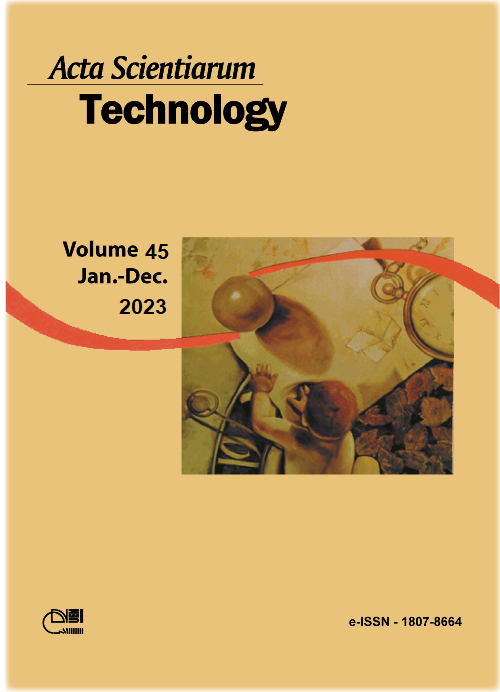Canonical correlation analysis applied to regulated deficit irrigation in `Tommy Atkins´ mango trees
DOI:
https://doi.org/10.4025/actascitechnol.v45i1.62882Palavras-chave:
grouping; multivariate analysis; water deficit; semi-arid region.Resumo
The objective was to identify the effect of regulated deficit irrigation on physiological, yield and root descriptors of `Tommy Atkins´ mango tree grown in a semi-arid region of Brazil. The work was carried out during two production cycles on an 11-year-old mango orchard. The design was randomized blocks with five treatments and six replications. Irrigation treatments were based on the trees´ development stage: T1, irrigation supplying 100% of the crop evapotranspiration (ETc) in three production stages: fruit set stage (SI), fruit expansion stage (SII), and physiological maturation stage of the fruits (SIII); T2, 50% ETc in SI and 100% ETc in SII and SIII; T3, 100% ETc in SI and SIII and 50% ETc in SII; T4, 100% ETc in SI and SII, and 50% ETc in SIII; and T5, without irrigation in all three stages. Physiological data were measured once per stage. After harvesting the second cycle, roots were collected, following a completely randomized design, with five treatments and three replications, to determine the total root length density. Total or partial water deficit in `Tommy Atkins´ mango trees was identified by decreasing transpiration (E) and photosynthesis (A) and increasing leaf temperature (Tleaf). The total root length density is similar in all irrigation strategies up to 1 m horizontal distance and 0.10 m depth. Water deficit applied in the physiological maturation stage improves yield and water use efficiency.
Downloads
Downloads
Publicado
Como Citar
Edição
Seção
Licença
DECLARAÇíO DE ORIGINALIDADE E DIREITOS AUTORAIS
Declaro que o presente artigo é original, não tendo sido submetido í publicação em qualquer outro periódico nacional ou internacional, quer seja em parte ou em sua totalidade.
Os direitos autorais pertencem exclusivamente aos autores. Os direitos de licenciamento utilizados pelo periódico é a licença Creative Commons Attribution 4.0 (CC BY 4.0): são permitidos o compartilhamento (cópia e distribuição do material em qualqer meio ou formato) e adaptação (remix, transformação e criação de material a partir do conteúdo assim licenciado para quaisquer fins, inclusive comerciais.
Recomenda-se a leitura desse link para maiores informações sobre o tema: fornecimento de créditos e referências de forma correta, entre outros detalhes cruciais para uso adequado do material licenciado.















